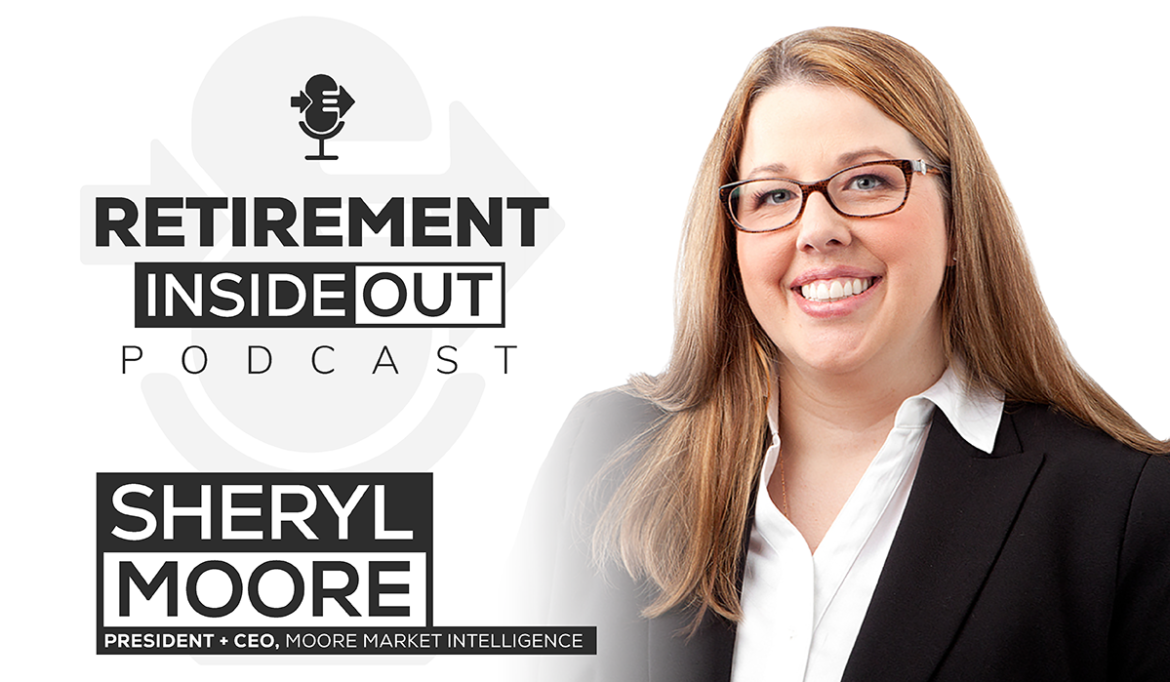Retirement Inside Out sat down with proclaimed “annuity rockstar” and “life insurance nerd” Sheryl Moore to talk regulation, changes, and shifts in the fixed insurance and annuity space.
A person of many titles, Sheryl is the chief storyteller at Wink, Inc., the president and CEO of Moore Market Intelligence, and a member of the Forbes Finance Council, just to name a few.
Throughout the episode, Sheryl had some incredibly insightful excerpts, so we went through and pulled some of our favorite moments and put them on paper (read: screen) to share her knowledge and passion for education with more people.
If you’re interested in hearing more of what Sheryl had to say in the episode, head to the Retirement Inside Out website to give the full episode a listen today!
Sheryl Moore Podcast Excerpts
[Could] you give some of those newer folks that may not have heard of you before or your services a little bit about your background, if you don’t mind, please?
Moore: So I’m a 22-year veteran of the life insurance industry. I used to work for an insurance company, but I went through kind of a traumatic experience as a young single mom of three with no child support when I learned by surprise after the dot-com bubble burst, that you can lose money in a 401(k). And I really felt uncomfortable about that. Nobody had explained it to me and certainly the insurance company that I was employed by didn’t provide any guidance beyond a prospectus for me to look at what I was investing in. And ultimately, it resulted in me learning about annuities and being a little, I guess, resentful of the fact that nobody had educated me on annuities, despite the fact that the company that I worked for was the top seller of indexed annuities at that time. So, it really ignited a fire in me.
And I started my own business 16 years ago with the intention of just educating people about life insurance and annuities. I am a third-party expert. I do not endorse any company or product. I run this market research firm that’s called Wink. You know, like wink, wink. I have the information you need, Tom. We just track all of the life and annuity companies and then their products with the features on those products, as well as the rates and sales of those annuities and life insurance products and how they’re marketed. So, I guess you would say anything that’s life and annuities we’ve got our hands in it one way or the other.
Related: Infographic: 7 Annuity Myths (And the Truths Behind Them)
Rate changes were something that was big even before 2020…we saw a lot of rate changes specifically on the 10-year note floating below 1%. How will that shape product development in our space and the fixed insurance space?
Moore: Well, you know, I remember in 2008-2009, when the market collapsed, thinking, “Oh my gosh, you know, this is the worst pricing environment we ever have because life insurance and annuity companies are being really challenged”—the most that they ever were up until that point to try and develop products that looked quote-unquote attractive. And I will tell you that this has really been an exercise for me to test my limits because after COVID-19 hit, we got to the point where, like you said, the 10-year treasury was below 1%.
And I think for those [listeners], who don’t really understand why that’s significant, you know, let’s just take a fixed annuity: When you purchase a fixed annuity, let’s say you put $100,000 in. What happens is the insurance company takes that $100,000 and usually will use it to purchase bonds. And they typically would correlate with the product purchase. So, if you bought a 10-year annuity, the insurance company is going to buy a 10-year bond. And it’s really discouraging when you see bond rates, you know, below 1%, because typically the way it would work is if the bonds are crediting 4%, let’s say the insurance company might pass on 3% credited interest to the fixed annuity. And the difference of 1% would be what they’d use to pay a commission to the salesperson, pay any administrative costs, and still make a profit.
So, you can probably imagine how all of those stakeholders needing to get something out of the annuity has made having a treasury rate of less than 1% a huge challenge in this industry, Tom, and working in product development for over 10 years, there are some trends that I’ve seen that happen: Anytime we have this cyclical behavior of low-interest rates, but what’s really interesting is that I’m seeing that product development is really being challenged more than ever before.
So in the past, when rates got quote-unquote low, I would see insurance companies developing new indexing methods for their indexed products or new ways of presenting the rates so that it appears attractive. Although it may not necessarily be any more attractive than the previous iterations of the product or adding bonuses and things to make the rate look more attractive. And, you know, I’m seeing that again, most definitely, but the methods that I’m seeing are really new and something that we’ve never seen in the insurance space before today.
Related: Michael Kitces Podcast Summary: Embrace Self-Advocacy in Financial Planning
We’d love your perspective on how [upcoming regulations are] going to affect the industry, both from the financial professional space and maybe an—if at all—from the consumer space?
Moore: Sure. I’d like to just hit on a couple of different regulatory items that are relevant to life insurance and annuities right now. I will say one regulation that I am really grateful for is the SECURE Act. And that basically gives the option to have annuities within a retirement plan, such as a 401(k), and it really relaxed some of the standards that need to be taken into consideration in order to offer guaranteed lifetime income options within a 401(k) or retirement plan. So, the reason I’m so excited about this is not because I think it’s going to present opportunities for new sales or really boost sales of annuities in general, because I think that we’re a long way off from that. We need insurance companies to be able to lay a foundation of administration and operations before they can comply with the SECURE Act.
But the reason I’m grateful for it, Tom, just because, you know, I personally fact-check all of the articles that have to do with annuities for the majority of the 16 years that I’ve run this business. And, you know, so often I’m seeing negative and inaccurate media even by really mainstream or quote-unquote credible sources of financial information. And what the SECURE Act has done is actually made it so that I’m seeing positive press about annuities. And I’m seeing journalists take better care and having integrity in what they’re reporting. So, you know, before, when I either had no publicity about annuities or generally really negative inaccurate information, now I’m actually seeing some positive information and that’s sparking consumers to say, “Well, what is an annuity?” And, “I need more information about that.”
So I’m really excited about [the] SECURE Act, but as it relates to the Department of Labor’s [DOL] fiduciary rule, I will say this: everyone in the life insurance industry really was distracted from the business of doing business back when the Department of Labor first proposed their fiduciary rule, and God bless them, you know, I love the people who I work with at DOL, but I think they had the best of intentions, but did not understand our business well when they proposed that rule. They’ve learned a lot since then. And I know there were a lot of people in this industry who feel like, “Whoa, you know, we really dodged a bullet with the DOL fiduciary rule!” And while that’s true that we didn’t necessarily have to deal with the DOL, we are now having to deal with a fiduciary or best interest standard, even if it’s not through the DOL. So, the Securities [and] Exchange Commission [SEC] is talking about a best interest standard, and we have individual states which have adopted a best interest standard. I think actually I saw [recently], Arkansas did it. And there’s probably, you know, there’s less than a dozen states who propose their own best interest standard.
But, I think that we all need to get comfortable with the fact that best interest regulation is coming. Whether it’s through the SEC or the DOL or individual states, it is coming. And luckily, we started laying that foundation when the DOL first proposed their rule. So, you know, I don’t think that this is such a huge deal because most of the people who I speak to really are acting in their client’s best interests, but it definitely is going to mean a change in how we do business. I think you and I were talking about AG49-A if I remember right too, that’s a regulation that just became effective [recently] that relates to indexed life. So, I have to tell you, this is really an issue that I’ve been working with regulators on since 2005. And, you know, the new regulation is interesting because it does say that products have multipliers and bonuses cannot be illustrated any more favorably than products that don’t have multipliers or bonuses.
And I think that was a good move forward. And there were regulations about, you know, loans—they used to be able to only show a 1% spread between credited interest and amount of interest charged. Now that’s been reduced to 50 basis points. But I feel like as often happens with regulation, you know, we’ve got a loophole here. I’ve been speculating aloud to a lot of people that I think we’re going to see a rise in the number of what I call “hybrid indexes” that are available on index life products to kind of help those illustrations to look more quote-unquote competitive, so to speak.
In the conversations you’re having in your marketing research…is there anything that you’ve heard that’s a consistent message or that people are saying, ‘This may be outside the norm of what the consumers are looking for,’ either in a financial advisor or they’re looking for from an education perspective; is there anything consistent that you’ve heard as a message or a need?
Moore: You know, the one thing that I keep hearing that I think the insurance industry has mostly had deaf ears on, and it’s really astounding to me, is that I have all these consumers reaching out to me normally via email, but sometimes by phone. And they’re trying to determine if annuities are right for them. And I’m very careful about what I say, because I am a licensed insurance agent, even though I’ve never sold a case, you know, I probably spend several hundred thousand dollars on annuities and life insurance every year for myself, my family, and my employees.
And so I’m careful in what I say to these folks, but what they’re saying to me as I’m trying to, you know, provide questions that help get them to the right place to get their answers is, “I just want something where my money is going to be safe.” So I’m getting this message of, “I’m more concerned about the return of my principal than the return on my principal.” And that’s just so ironic to me because in this very low-interest-rate period, what everybody seems to be focusing on is accumulation and potential for returns and talking about, you know, opportunities for double-digit gains when really what consumers are worried about is just getting their money back. So that’s been the most interesting thing that I’ve seen.


